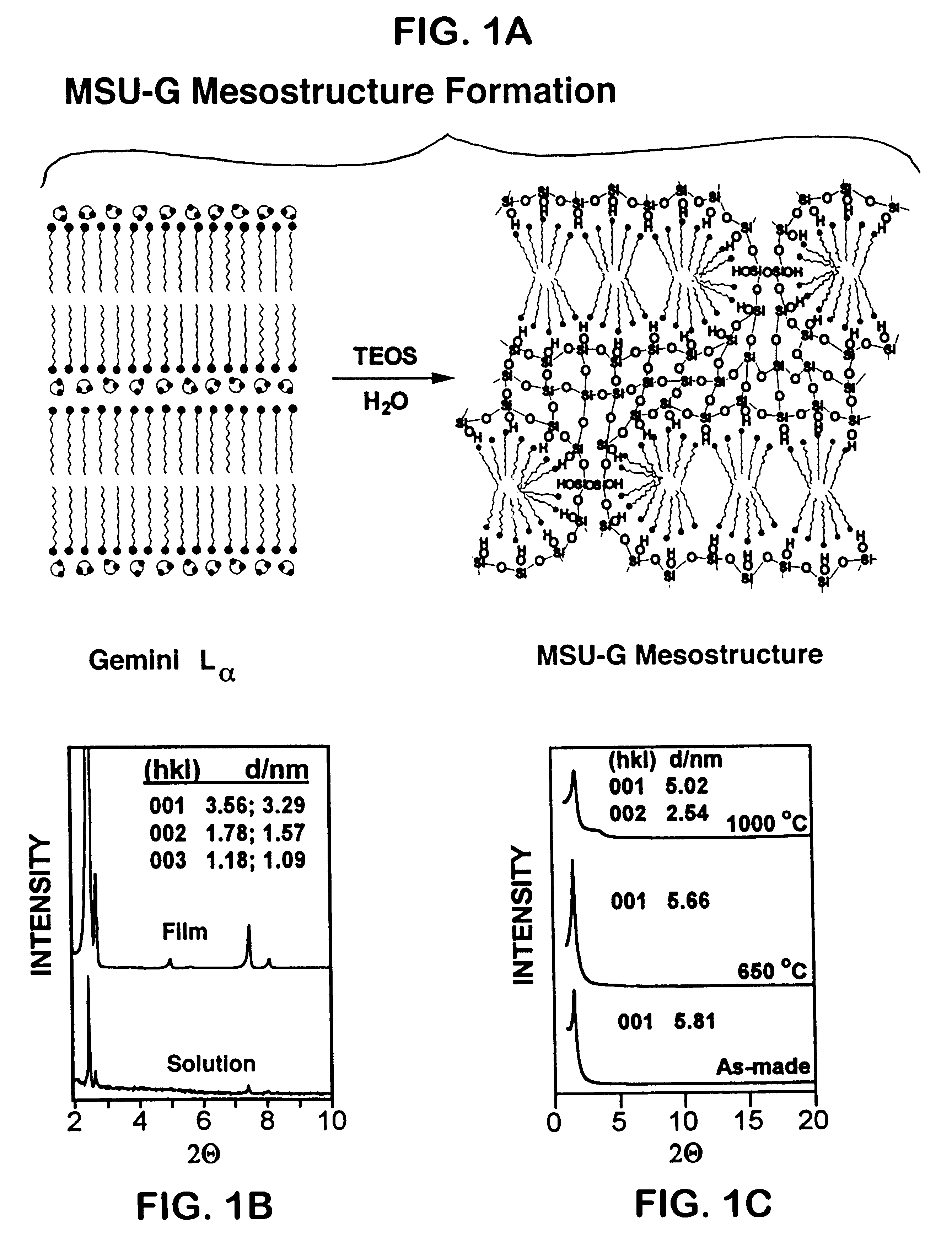Ultra-stable lamellar mesoporous silica compositions and process for the preparation thereof
a technology of mesoporous silica and composition, which is applied in the direction of molecular-sieve silica-polymorphs, silicon oxides, silicon compounds, etc., can solve the problems of limiting the shape selectivity and the effectiveness of adsorbents, all of the vesicle-like mesostructures reported to date have undesirable thicknesses
- Summary
- Abstract
- Description
- Claims
- Application Information
AI Technical Summary
Benefits of technology
Problems solved by technology
Method used
Image
Examples
experimental examples 1 to 3
Thirty five milliliters of deionized H.sub.2 O was mixed with five milliliters of ethanol under stirring and the appropriate amount of neutral Gemini surfactant template (see Table 1) was added. These neutral Gemini surfactants used in the preparation were synthesized by previously described procedures (F. Linsker and R. L. Evans, J. Am. Chem. Soc., 67, 158 (1945)). The resultant mixture was stirred at room temperature for 20 hours until a milky solution of template was obtained. A 5.2 gram-quantity of Si(OC.sub.2 H.sub.5).sub.4 was added to the above solution of template and stirred at room temperature for 3 minutes. The reaction stoichiometry expressed in terms of moles per mole SiO.sub.2 corresponded to the following:
0.25 moles C.sub.n H.sub.2n+1 NH(CH.sub.2).sub.2 NH.sub.2
78 moles H.sub.2 O
4.3 moles of EtOH.
The resulting gels were transferred into a Teflon-lined autoclave and aged at 100.degree. C. for 48 hours under autogenous pressure. After the autoclave was cooled to room te...
example 6
The following examples were prepared to test the thermal and hydrothermal stabilities of the product of Example 2. The same procedure as described above for Examples 5 through 6 was employed for testing the stability of Example 2.
The product exhibited the same N.sub.2 adsorption-desorption isotherms (FIG. 8) without any significant change after the hydrothermal treatment at 100.degree. C. for 56 hours. After calcination at 1000.degree. C. for 4 hours, the product exhibited two diffraction lines (FIG. 9) that are consistent with an undulated lamellar structure.
The sample still showed a step in the N.sub.2 adsorption isotherm for the filling of mesopores between P / P.sub.o at 0.2 and 0.3 (FIG. 8). The pore volume of the sample (0.31 cm.sup.3 / g) only decreased by 25% respective to that of calcined sample at 650.degree. C. for 4 hours (0.42 cm.sup.3 / g). Thus, the product of Example 2 was found to be superior in thermal and hydrothermal stability among the all previously reported mesopo...
example 7
This example describes another preparation art for the incorporated Al centers into the framework of an Example 2 silica by post-synthesis reaction of the mesostructure in the absence of template.
One gram of the air-dried and non-calcined product of Example 2 was mixed with 100 milliliters of EtOH, stirred and refluxed for 1 hour. The product was then filtered and washed with another portion of EtOH (100 milliliters). The above washing procedure was repeated twice and the filtered product was air-dried at 100.degree. C. overnight. The solvent extraction led to the removal of more than 95% of the template, which was confirmed by C, H, N elemental analysis and .sup.13 C MAS NMR. Alumination was conducted by heating a 0.5 gram of ethanol-extracted product in 25 milliliters of 0.1 M aqueous solution of sodium aluminate in a tightly sealed flask. The flask was immersed in an oil bath at 60.degree. C. for 1 hour. The sample was filtered, washed with water, and calcined in air at 620.degre...
PUM
| Property | Measurement | Unit |
|---|---|---|
| thickness | aaaaa | aaaaa |
| thickness | aaaaa | aaaaa |
| diameter | aaaaa | aaaaa |
Abstract
Description
Claims
Application Information
 Login to View More
Login to View More - R&D
- Intellectual Property
- Life Sciences
- Materials
- Tech Scout
- Unparalleled Data Quality
- Higher Quality Content
- 60% Fewer Hallucinations
Browse by: Latest US Patents, China's latest patents, Technical Efficacy Thesaurus, Application Domain, Technology Topic, Popular Technical Reports.
© 2025 PatSnap. All rights reserved.Legal|Privacy policy|Modern Slavery Act Transparency Statement|Sitemap|About US| Contact US: help@patsnap.com

